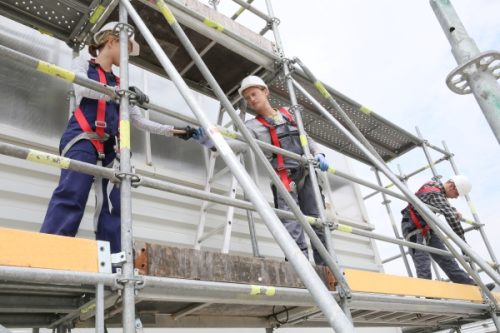
Scaffolding is a crucial component in construction projects, providing temporary support and access for workers to carry out various tasks at heights safely. In the UK, scaffolding is subject to strict regulations and guidelines to ensure safety and prevent accidents. The Health and Safety Executive (HSE) sets out specific requirements for scaffolding design, erection, and use, which must be adhered to by law. Additionally, employers are required to have appropriate insurance coverage for their employees working on scaffolds. Failure to comply with these regulations can result in serious consequences, including fines and even criminal prosecution. Therefore, it is essential to understand the legal aspects and insurance requirements surrounding scaffolding to avoid any potential risks or penalties.
Understanding Scaffolding Regulations in the UK
Scaffolding regulations are governed by several key laws and regulations, which aim to ensure safety standards and compliance during construction projects. The Health and Safety at Work etc. Act 1974 sets out the general framework for workplace health and safety regulations, while the Construction (Design and Management) Regulations 2015 (CDM 2015) specifically address the management of construction projects, including scaffolding. Additionally, the Working at Height Regulations 2005 provide guidelines for working at height, including the use of scaffolding. The National Access and Scaffolding Confederation (NASC) also provides guidance and industry standards for scaffolding. Compliance with these regulations is essential to ensure the safety of workers and the public, and failure to adhere to them can result in serious consequences, including fines and legal action. Therefore, it is crucial to understand and implement these regulations when working with scaffolding.
The Role of Health and Safety Executive (HSE)
The Health and Safety Executive (HSE) plays a crucial role in enforcing scaffolding regulations. They are responsible for ensuring that employers comply with relevant laws and regulations. The HSE conducts inspections and investigations to identify breaches of these regulations and may issue notices of improvement or prohibition to non-compliant employers. Failure to comply can result in fines of up to £20,000, or even imprisonment in cases where serious risk to human life is posed. Additionally, employees who suffer injuries due to non-compliance may file claims against their employers. Therefore, employers need to understand and adhere to scaffolding regulations to avoid legal and financial consequences.
Why Compliance Matters
Compliance with scaffolding laws matters because it ensures the safety of both workers and the public. Non-compliant scaffolding poses a serious risk of collapse, injury, or fatality. Moreover, failure to adhere to regulations can result in costly fines, legal action, and damage to reputation. Businesses must understand that investing in proper scaffolding equipment and training is essential to protect their workers and avoid financial losses due to non-compliance. Additionally, complying with regulations helps maintain high industry standards, which benefits society as a whole by reducing the likelihood of accidents and promoting a positive image of the construction industry.
Specialist Insurance: A Necessity

Specialist insurance for scaffolding work is a necessity because it provides coverage for unique risks associated with the industry. It offers protection against various hazards, including accidents, damages, and unforeseen events. This type of insurance helps manage risks by covering medical expenses, legal fees, and repair costs. Additionally, it shields against financial losses due to unexpected project delays or cancellations. With specialised insurance, scaffolding companies can minimise the impact of unpredictable events and focus on delivering quality services to clients. Overall, investing in specialist insurance is vital for long-term success and peace of mind in the scaffolding industry.
Types of Specialist Insurance
When it comes to scaffolding projects, several types of specialist insurance can help protect your business from various risks. Here are some of the most important ones to consider:
- Public Liability Insurance: This type of insurance covers damages or injuries to third parties, including clients, pedestrians, and other contractors. It’s especially important when working on large construction sites where there are many people present.
- Employers Liability Insurance: If you employ any staff, whether full-time, part-time, or temporary, you’ll need this type of insurance to protect yourself against claims arising from employee injuries or illnesses.
- Contractors All Risks (CAR) Insurance: CAR insurance provides comprehensive coverage for construction projects, including materials, equipment, and labour costs. It can also cover unexpected events such as natural disasters, fire, and theft.
- Professional Indemnity Insurance: Also known as Errors and Omissions insurance, this type of insurance protects your business against negligence claims arising from professional services or advice given to clients.
- Own Plant and Hired in Plant Insurance: This type of insurance covers your owned or rented equipment and tools, ensuring that you’re protected against loss, damage, or theft.
- Group Personal Accident Insurance: This type of insurance provides coverage for employees in case of accidental death, permanent disablement, or medical expenses.
How to Ensure Compliance and Insurance Coverage

To ensure compliance and adequate insurance coverage for scaffolding operations, businesses should follow a few key steps. Firstly, it’s important to familiarise oneself with the relevant regulations and standards, such as the aforementioned NASC guidelines and Health & Safety Executive (HSE) legislation. This can involve attending training courses or seeking advice from experts in the field. Next, conduct a thorough risk assessment to identify potential hazards and implement appropriate controls. This should include selecting the right type of scaffolding for the job, ensuring proper assembly and maintenance, and providing suitable personal protective equipment (PPE) for workers. Finally, securing the right insurance coverage is crucial to protect against unexpected losses or damages. Construction Insure offers a range of policies specifically designed for scaffolding companies, including public liability, employer’s liability, and contractor’s all-risk insurance.
Benefits of Compliance and Insurance
Adhering to scaffolding laws and regulations can bring numerous benefits to a business. Firstly, it ensures the safety of employees, customers, and the general public, which is a moral and ethical responsibility. Additionally, being compliant can help avoid legal issues and fines, which can save a company time, money, and reputation. Furthermore, having specialised insurance can provide financial protection in case of accidents, damages, or other unforeseen events. This can help a business recover quickly and minimise downtime, ultimately leading to increased productivity and profitability. Moreover, being properly insured can also instil confidence in clients, as they know that their projects are in safe hands. Lastly, compliance and insurance can contribute to a company’s reputation and credibility, making it more attractive to potential customers and partners.
Compliance and specialist insurance are crucial for construction businesses. Failure to adhere to health and safety regulations can result in severe penalties, while environmental breaches can damage reputation and bottom line. Anti-bribery and corruption measures are essential to avoid criminal charges and reputational harm. Specialist insurance can mitigate risks and provide financial protection. By prioritising compliance and investing in appropriate insurance coverage, construction firms can safeguard their future and maintain a positive reputation in the industry.
Sources:
https://scaffoldingcosts.co.uk/uk-scaffolding-regulations/&output=embed
https://resources.hse.gov.uk/convictions-history/breach/breach_list.asp?PN=1&ST=B&SN=F&EO=%3D&SF=SIC&SV=43991&SO=DHD
https://www.ncbi.nlm.nih.gov/pmc/articles/PMC6284184/
https://www.sentrysm.co.uk/blog/basic-scaffolding-regulations-you-need-to-know/

